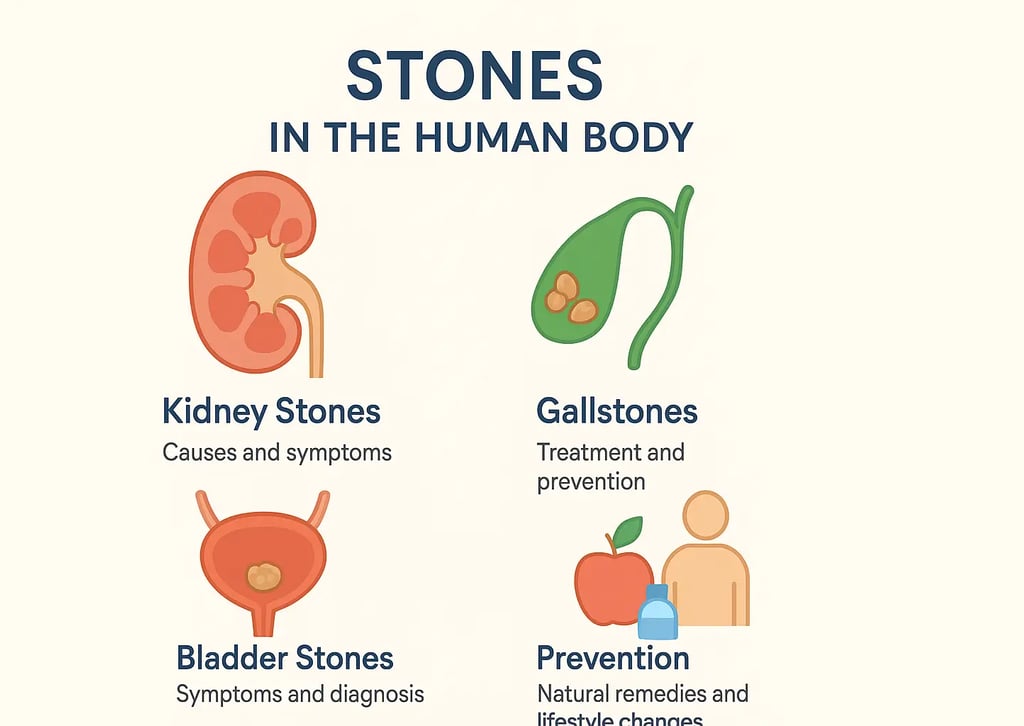Stones in the Human Body: Types, Causes, Symptoms, and Natural Prevention
Discover everything about stones in the human body, including kidney stones, gallstones, and bladder stones. Learn their causes, symptoms, risk factors, diagnosis, and natural prevention tips.


Stones in the Human Body: Causes, Types, Symptoms, and Treatments
Stones in the human body, also called calculi, are hard masses that form when minerals and other substances crystallize inside organs. These stones can occur in the kidneys, gallbladder, or bladder, and their size, composition, and effects may vary. While some stones cause no symptoms, others can lead to severe pain, urinary problems, or digestive issues.
In this guide, we’ll explore the types of stones, why they form, common risk factors, prevention tips, symptoms, and available treatments.
Types of Stones in the Human Body
1. Kidney Stones
Kidney stones are the most common type, formed when salts and minerals—such as calcium oxalate, uric acid, struvite, or cystine—crystallize in the kidneys. They can be tiny grains or large enough to block the urinary tract.
Symptoms: Sharp back or abdominal pain, blood in urine, nausea, and painful urination.
2. Gallstones
Gallstones form inside the gallbladder due to imbalances in bile components. They are mainly made of cholesterol or bilirubin. While some people remain symptom-free, gallstones can block bile ducts, leading to severe abdominal pain, indigestion, or jaundice.
3. Bladder Stones
Bladder stones develop when concentrated urine causes minerals to crystallize. Factors like urinary retention, infections, or dehydration increase the risk. These stones can irritate the bladder lining, resulting in painful urination, blood in urine, or frequent urge to urinate.
How Do Stones Form in the Body?
Stone formation is influenced by multiple factors:
Metabolic Factors: Imbalances in calcium, oxalate, and uric acid metabolism increase stone risk.
Dietary Habits: High intake of oxalate-rich foods (spinach, nuts), salt, or animal protein can trigger stones. Low water intake also contributes.
Genetics: Inherited conditions may impair mineral processing, making individuals more prone to stones.
Medical Conditions: Disorders like hyperparathyroidism, chronic kidney disease, or infections may accelerate stone development.
Risk Factors and Prevention of Stones
Risk Factors
Dehydration – concentrated urine leads to crystallization.
Obesity – alters urine composition.
High sodium & protein diet – increases stone formation.
Certain medications – diuretics and calcium supplements may increase risk.
Prevention Tips
Drink 8–10 glasses of water daily to dilute minerals.
Eat a balanced diet rich in fruits, vegetables, and moderate calcium.
Limit red meat, excess salt, and processed foods.
Consume citrate-rich foods (lemons, oranges) to prevent crystallization.
Maintain a healthy weight with regular exercise.
Symptoms of Stones in the Human Body
Sharp pain in back, abdomen, or groin
Blood in urine (hematuria)
Frequent or painful urination
Nausea, vomiting, or fever in severe cases
Sudden urinary blockage
Diagnosis of Stones
Doctors use a combination of methods to confirm the presence of stones:
Ultrasound or CT scan – to detect size and location.
Urine analysis – to check for crystals, blood, or infection.
Blood tests – to identify mineral imbalances.
Treatment Options
Treatment depends on stone size, type, and severity of symptoms:
Small stones: Often pass naturally with increased water intake, pain relievers, and home remedies like lemon water or apple cider vinegar.
Medium to large stones:
Extracorporeal Shock Wave Lithotripsy (ESWL): Breaks stones into smaller pieces.
Ureteroscopy: Removes stones using a thin scope.
Surgery: Needed in severe or recurrent cases.
Final Thoughts
Stones in the human body—whether kidney stones, gallstones, or bladder stones—are painful but preventable. Staying hydrated, eating a balanced diet, and adopting healthy lifestyle habits can significantly reduce your risk. If you suspect symptoms, seek medical attention early for timely diagnosis and treatment.
